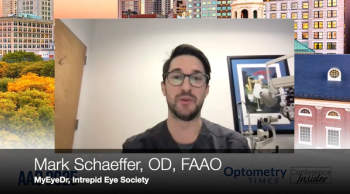
How Trumpcare affects optometry
The American Health Care Act (AHCA)-or Trumpcare-will provide fewer people with healthcare coverage than the Affordable Care Act (ACA) or Obamacare, cost more, and significantly reduce Medicaid funding, says the Congressional Budget Office (CBO) and other experts.
The American Health Care Act (AHCA)-or Trumpcare-will provide fewer people with healthcare coverage than the Affordable Care Act (ACA) or Obamacare, cost more, and significantly reduce Medicaid funding, says the Congressional Budget Office (CBO) and other experts.
The ACHA is supported by Speaker of the House Paul Ryan (R-WI) and touted as a “trillion-dollar tax cut.”1 It was released in early March.
Fewer lives covered means that ODs must understand the potential impacts on population health-especially as it pertains to early intervention for chronic conditions and diseases and reducing risk for vision impairment.
Quick snapshot
The CBO analysis on the AHCA included information on number of people covered, premium costs, and savings.2
• 24 million fewer people covered than under the ACA in 10 years
• Premium costs are projected to be 15 to 20 percent higher in 2018-2019
• The deficit is projected to be reduced by $337 billion over 10 years
Several popular ACA features remain in the AHCA, including:
• No denial or increased costs for pre-existing conditions
• Young adults are able to remain on a parent’s insurance policy until age 26
• Existing Medicaid expansion remains as is until 2020
Penalties imposed under the ACA for not purchasing insurance are removed and replaced with a 30 percent surcharge on premiums if a consumer allows coverage lapse.
ACA subsidies are removed and replaced with new tax credits to subsidize insurance premiums, providing more benefit to younger vs. older people.
For example, a 30-year-old would receive $2,000 to put toward coverage, while a 60-year-old would receive $4,000. The amounts are weighted by age. People in their 50s and 60s are especially at risk for finding affordable coverage.3
The tax credits apply to anyone making up to $75,000 or to a married couple filing jointly making up to $150,000. After that threshold, tax credit amounts phase out in 10 percent increments.
Putting it into context
The CBO’s finding that 24 million people will lose health coverage under the plan over 10 years is even greater than what had been anticipated-the Brookings Institution previously projected an estimate of 15 million people.2
While most experts agreed there would be some reduction in coverage, Republican supporters of the new plan are countering with the stance that their approach does not directly compete with the ACA’s requirement to purchase insurance.
They have also been quick to dismiss the CBO projections, which are arguably more dire than expected, especially for populations in the plan’s economic line of fire. Key groups receiving Medicaid coverage include individuals with disabilities, children, and older adults.4
Medicaid cuts
In addition, the biggest losers under the AHCA are individuals covered by Medicaid, a state and federal program which offers coverage to more than 72.5 million low-income Americans and serves as the country’s single largest source of health care.5
While the ACA provided states with the opportunity for Medicaid expansion-31 states plus the District of Columbia chose expansion-the ACA repeal-and-replace strategy rolls Medicaid coverage back.6,7
Key statistics that provide perspective on the importance and scope of Medicaid include:4
• Medicaid programs covers 72 million people in the U.S.
• 50 percent of all births in the country are paid for by Medicaid
• Approximately a third of our country’s children are covered under Medicaid
• Half of all long-term care in the country is covered by Medicaid
By contrast, the AHCA:8
• Eliminates funding that supported states’ expansion of Medicaid
• Restructures Medicaid’s federal financing system
• Does not provide states with flexibility to absorb funding cuts
• Forces states accept the terms of a diminished financial deal or give up federal funds entirely
4 reasons why this is important to ODs
Any changes to federal healthcare regulations have the potential to affect optometry. Keep these four reasons in mind when evaluating the AHCA or other potential healthcare policies.
• Under the ACA, pediatric eye care is a required benefit included on all health insurance plans that qualify as minimum essential coverage; most Medicaid plans meet this qualification and cover comprehensive eye examinations for children10
• All children under age 19 in individual, family, and small group markets must be offered eye care as an essential health benefit; loss of Medicaid coverage will adversely affect children’s eye and vision health, especially in underserved and low-income communities4
• Essential health benefits, including comprehensive eye examinations for children, could be erased with future bills and/or modifications
• The National Academies of Sciences, Engineering, and Medicine (NASEM) report shows insurance coverage is an independent predictor of vision health; a lack of insurance coverage is associated with a higher incidence of vision loss and an older mean age of diagnosis for degenerative diseases like glaucoma.9
References
1. DeBonis M. Ryan: Health care plan must change to pass the House. Wash Post. Available at:
2. Adler L, Fielder M. Expect the CBO to estimate large coverage losses from the GOP health care plan. Brookings Institute. Available at:
3. Goodnough A, Abelson R. Millions risk losing health insurance in Republican plan, analysts say. NY Times. Available at:
4. Center on Budget and Policy Priorities. Policy Basics: Introduction to Medicaid. Available at:
5. Medicaid. Eligibility. Available at:
6. Rosenbaum S. The American Health Care Act And Medicaid: Changing A Half-Century Federal-State Partnership. Health Affairs Blog. Available at:
7. Martin R. Molina Healthcare CEO Expresses Doubts About GOP's Health Plan. Morning Edition. Available at:
8. Musumeci M, Foutz J. Medicaid Restructuring Under the American Health Care Act and Nonelderly Adults with Disabilities. Kaiser Family Foundation. Available at:
9. National Academies of Sciences, Engineering, and Medicine. Making Eye Health a Population Health Imperative: Vision for Tomorrow. Availabile at:
10. Obamacare Facts. Vision insurance. Available at:
Newsletter
Want more insights like this? Subscribe to Optometry Times and get clinical pearls and practice tips delivered straight to your inbox.



















































.png)


